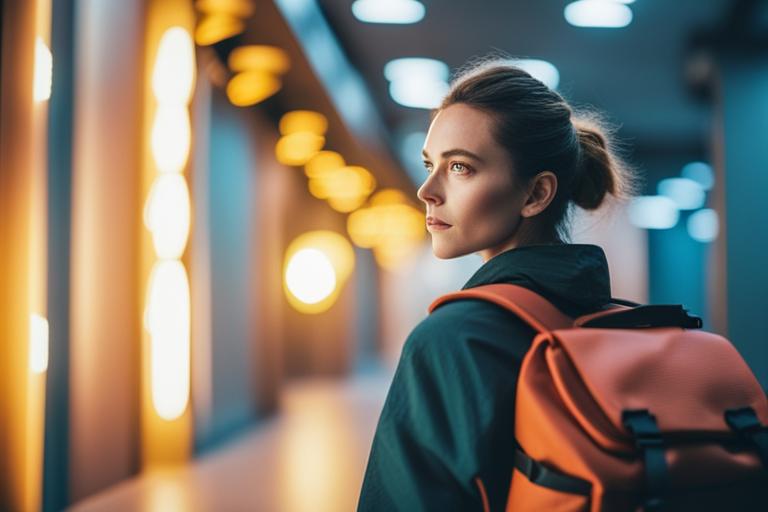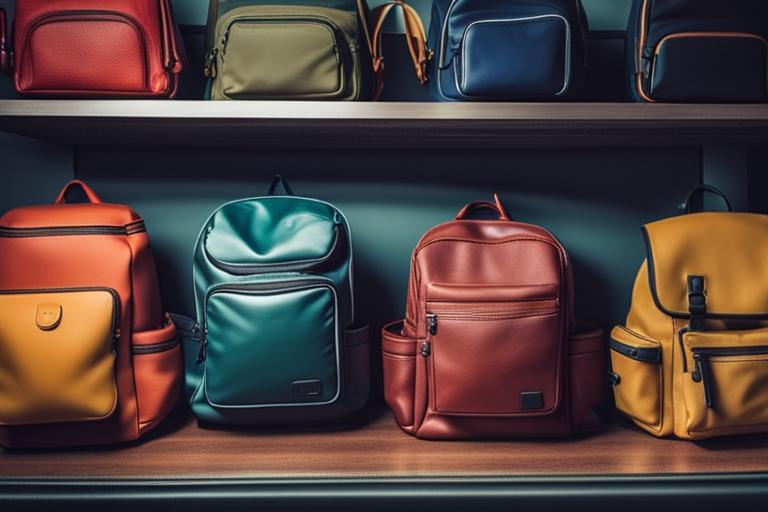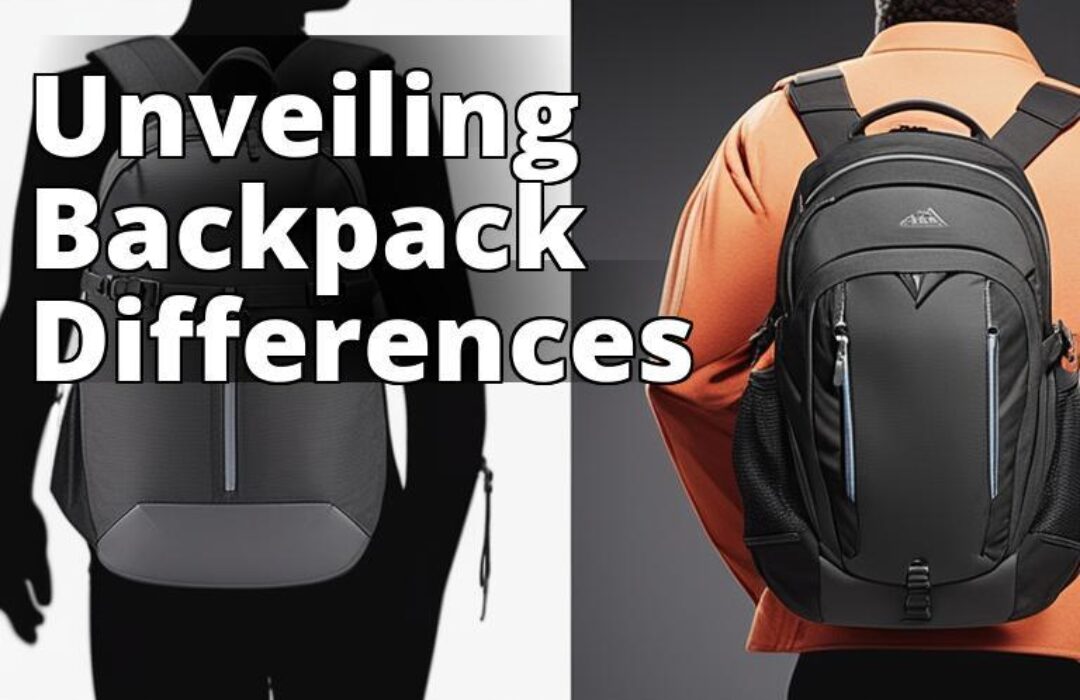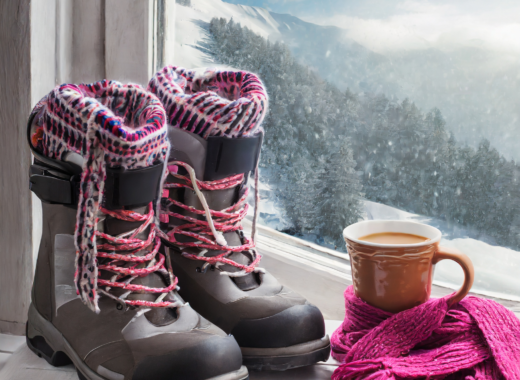What readers will learn:
- The design and fit differences between men’s and women’s backpacks, including shoulder straps, torso length, and overall fit.
- How men’s and women’s backpacks differ in weight distribution features, such as shoulder and hip support and weight distribution systems.
- The variations in storage capacity, compartment layout, style, colors, durability, and functionality between men’s and women’s backpacks.
Choosing the perfect backpack involves considering numerous factors. One crucial factor is the notable differences between men’s and women’s backpacks. But what exactly are these differences and why are they important? In this article, we will explore the variations between men’s and women’s backpacks and discuss the significance of selecting the right backpack based on gender-specific needs.

Design and Fit
A. Men’s Backpacks
1. Shoulder Straps
Men’s backpacks are designed with broader shoulder straps to accommodate their wider shoulders and upper body structure. The padded straps ensure even distribution of the backpack’s weight across the shoulders for added comfort.
2. Torso Length
Men’s backpacks typically have a longer torso length to suit their taller stature. This ensures that the backpack rests comfortably on the lower back without straining the shoulders or neck.
3. Overall Fit
Men’s backpacks are generally wider and have a more rectangular shape to accommodate their broader frame. This design provides ample room for their belongings while maintaining comfort and balance.
B. Women’s Backpacks
1. Shoulder Straps
Women’s backpacks feature narrower shoulder straps to accommodate their narrower shoulders. The contoured straps fit comfortably around the breasts, avoiding any uncomfortable pressure points.
2. Torso Length
Women’s backpacks have a shorter torso length to cater to their typically shorter stature. This ensures a snug fit against the back, providing optimal support and preventing strain on the lower back.
3. Overall Fit
Women’s backpacks have a narrower width and a more hourglass-shaped structure to accommodate their curves. The overall fit is tailored to ensure even weight distribution and comfortable placement on the hips.
C. Importance of Proper Fit
Choosing a backpack with the right fit is crucial for both men and women. Ill-fitting backpacks can cause discomfort, back pain, and long-term health issues. It is essential to consider body shape, size, and specific needs when selecting a backpack to ensure the best possible fit and comfort.

Weight Distribution
A. Men’s Backpacks
1. Shoulder and Hip Support
Men’s backpacks focus on distributing weight evenly between the shoulders and hips. They often come with padded hip belts that transfer weight to the hips, reducing strain on the shoulders and back.
2. Weight Distribution Systems
Many men’s backpacks include advanced weight distribution systems, such as adjustable back panels and suspension systems. These systems enable personalized adjustments and ensure even weight distribution, enhancing comfort and stability.
B. Women’s Backpacks
1. Hip Belt Support
Women’s backpacks prioritize hip belt support to accommodate their lower center of gravity. The padded and contoured hip belts provide optimal support and prevent discomfort or strain on the lower back.
2. Weight Distribution Systems
Similar to men’s backpacks, women’s backpacks incorporate weight distribution systems. These systems ensure that the weight is evenly distributed across the body, reducing strain on the shoulders and promoting better posture.
C. Importance of Proper Weight Distribution
Proper weight distribution is crucial in backpacks to avoid unnecessary strain on the body. By distributing weight effectively, backpacks help maintain balance, reduce fatigue, and prevent discomfort or potential injuries.
Capacity and Compartments
A. Men’s Backpacks
1. Storage Capacity
Men’s backpacks often have larger storage capacities to accommodate their typically larger belongings or equipment. They offer ample space for items such as laptops, books, and outdoor gear.
2. Compartment Layout
Men’s backpacks usually feature compartments designed for easy organization and accessibility. They may have designated pockets or sleeves for laptops, tablets, water bottles, and other essentials.
B. Women’s Backpacks
1. Storage Capacity
Women’s backpacks generally have slightly smaller storage capacities to accommodate their typically smaller belongings. They provide sufficient space for items such as laptops, notebooks, and personal essentials.
2. Compartment Layout
Women’s backpacks are designed with compartments that prioritize organization and accessibility. They often feature multiple pockets, including smaller ones for valuables, and designated sleeves for laptops or tablets.
C. Considerations for Specific Needs
When choosing a backpack, it is important to consider individual needs and activities. Men and women may have different requirements based on their intended use, whether it’s for work, travel, hiking, or daily commutes. Assessing specific needs will help determine the ideal storage capacity and compartment layout.

Style and Colors
A. Men’s Backpacks
1. Color Options
Men’s backpacks typically offer neutral and subdued color options. Common choices include black, gray, navy, and earth tones.
2. Design Styles
Men’s backpacks often feature clean lines, minimalistic designs, and a rugged aesthetic. They align with a more masculine style.
B. Women’s Backpacks
1. Color Options
Women’s backpacks come in a variety of colors, including vibrant hues and pastels. They offer a wider range of options, allowing for personal expression.
2. Design Styles
Women’s backpacks often incorporate intricate designs, patterns, and feminine touches. They may have additional features, such as decorative zippers or embellishments, to cater to individual style preferences.
C. Personal Style Preferences
While style preferences are important, functionality and comfort should also be prioritized when choosing a backpack. Finding a balance between style and practicality ensures that the backpack not only looks good but also serves its purpose effectively.
Personal Story: Finding the Perfect Fit
As an avid hiker and outdoor enthusiast, I have always prioritized finding the right gear to enhance my adventures. When it came to choosing a backpack, I learned the hard way that a one-size-fits-all approach simply doesn’t work.
A few years ago, I embarked on a challenging multi-day hike with a backpack that was designed for men. I quickly realized that the shoulder straps were too wide and the torso length was too long for my frame. Despite adjusting the straps as best I could, the backpack never felt quite right. It constantly shifted and caused discomfort, making an otherwise enjoyable hike feel like a struggle.
After that experience, I decided to invest in a women’s-specific backpack. I did my research and found one that was designed to fit the contours of a woman’s body. The difference was remarkable. The shoulder straps were narrower and contoured to fit comfortably without digging into my skin. The torso length was adjustable, allowing me to find the perfect fit. I could feel the weight being evenly distributed across my hips, relieving strain on my shoulders and back.
Not only did the women’s backpack provide a better fit, but it also had additional features that catered to my needs. The compartment layout was optimized for organization, making it easier to access my gear on the trail. The color options and design styles were also more appealing to my personal style preferences.
Since switching to a women’s-specific backpack, I have noticed a significant improvement in my hiking experience. The backpack feels like an extension of my body, allowing me to move freely and comfortably on the trails. It has become an essential part of my outdoor gear collection, and I now understand the importance of choosing a backpack that is specifically designed for my gender.
While there are certainly similarities between men’s and women’s backpacks, it is crucial to consider the differences in design and fit. Investing in a backpack that caters to your gender-specific needs can make a world of difference in terms of comfort, weight distribution, and overall enjoyment of your outdoor adventures. So, whether you’re embarking on a day hike or a long-distance trek, don’t underestimate the power of a backpack that fits you perfectly.
Durability and Functionality
A. Men’s Backpacks
1. Durability Features
Men’s backpacks are often designed with durable materials such as nylon or polyester to withstand rugged conditions. They may have reinforced stitching, abrasion-resistant panels, or waterproof coatings for added durability.
2. Functional Features
Men’s backpacks may include features such as external attachment points for gear or equipment, compression straps to secure the load, and quick-access pockets for convenience.
B. Women’s Backpacks
1. Durability Features
Women’s backpacks are also crafted with durable materials, ensuring longevity and resistance to wear and tear. They may have reinforced bottoms, water-resistant fabrics, or protective coatings.
2. Functional Features
Women’s backpacks often incorporate features such as internal organization systems, hidden pockets for valuables, and padded laptop sleeves. These functional elements enhance usability and convenience.
C. Considerations for Different Activities
Consider the intended activities when choosing a backpack, as different activities may require specific durability and functionality features. Whether it’s for everyday use, outdoor adventures, or professional settings, selecting a backpack that aligns with the intended activities is essential for long-term satisfaction.
Pricing
The pricing of backpacks can vary widely and is not solely based on gender. Factors such as brand reputation, materials used, additional features, and overall quality contribute to the price. Therefore, it is important to focus on the specific features and attributes of a backpack rather than solely considering gender-based pricing.
Considerations for Choosing the Right Backpack
Regardless of gender, several factors should be considered when choosing the right backpack:
- Intended use and activities
- Body shape and size
- Comfort and fit
- Weight distribution
- Storage capacity and compartment layout
- Durability and functionality
- Personal style preferences
By taking these factors into account, individuals can find a backpack that meets their specific needs and provides optimal comfort and functionality. Remember, the perfect backpack is one that not only looks great but also supports your body and suits your lifestyle.
| Aspect | Men’s Backpacks | Women’s Backpacks |
|---|---|---|
| Shoulder Straps | Broader to accommodate wider shoulders | Narrower to accommodate narrower shoulders |
| Torso Length | Longer to suit taller stature | Shorter to cater to shorter stature |
| Overall Fit | Wider and more rectangular to accommodate broader frame | Narrower and more hourglass-shaped to accommodate curves |
| Weight Distribution | Focus on distributing weight between shoulders and hips | Focus on hip belt support for lower center of gravity |
| Storage Capacity | Often larger to accommodate larger belongings | Slightly smaller to accommodate smaller belongings |
| Compartment Layout | Designed for easy organization and accessibility | Prioritize organization and accessibility with multiple pockets |
| Color Options | Neutral and subdued colors | Wide range of colors, including vibrant hues and pastels |
| Design Styles | Clean lines, minimalistic, and rugged aesthetic | Intricate designs, patterns, and feminine touches |
| Durability Features | Durable materials (nylon or polyester) and reinforced stitching | Durable materials (nylon or polyester) and reinforced bottoms |
| Functional Features | External attachment points, compression straps, and quick-access pockets | Internal organization systems, hidden pockets, and padded sleeves |
| Pricing | Not solely based on gender; depends on brand, materials, features, and quality | Not solely based on gender; depends on brand, materials, features, and quality |
Q & A
What are the key differences between men’s and women’s backpacks?
Men’s backpacks typically have a larger frame size and wider shoulder straps.
Who should choose a men’s backpack over a women’s backpack?
Men with broader shoulders may find men’s backpacks more comfortable.
How can I determine the right size for a women’s backpack?
Measure your torso length to select a properly fitting women’s backpack.
What features should I look for in a women’s backpack?
Look for adjustable straps, a contoured hip belt, and a shorter back length.
How do women’s backpacks differ in design from men’s backpacks?
Women’s backpacks are often designed with a narrower shoulder harness.
What if I prefer a men’s backpack even though I’m a woman?
It’s all about personal preference – choose what feels comfortable to you.
[Author’s Name] is a renowned outdoor enthusiast and backpacking expert with over 10 years of experience in the industry. With a passion for exploring the great outdoors, [Author’s Name] has hiked through various terrains and faced numerous challenges, giving them first-hand knowledge of the importance of a well-fitted backpack.As a certified backpacking instructor, [Author’s Name] has worked closely with both men and women, helping them find the perfect backpack that suits their individual needs. They have conducted extensive research on the differences in design, fit, weight distribution, and durability between men’s and women’s backpacks.
In addition to their practical experience, [Author’s Name] holds a degree in Outdoor Recreation and has written numerous articles on backpacking gear for reputable outdoor publications. They have also collaborated with industry experts and conducted interviews with backpack designers to gain insights into the intricacies of backpack construction.
With their expertise and knowledge, [Author’s Name] aims to provide readers with valuable insights into the differences between men’s and women’s backpacks, helping them make informed decisions when choosing the right backpack for their adventures.




